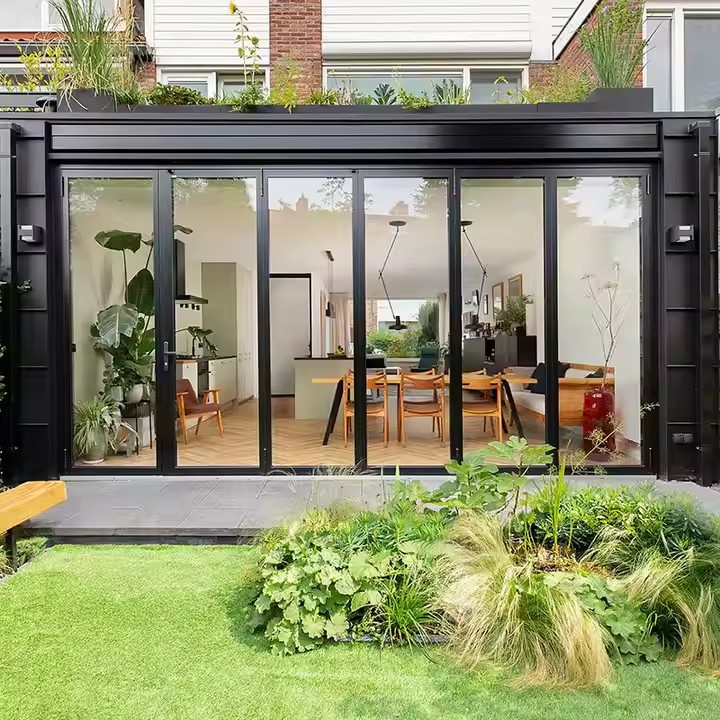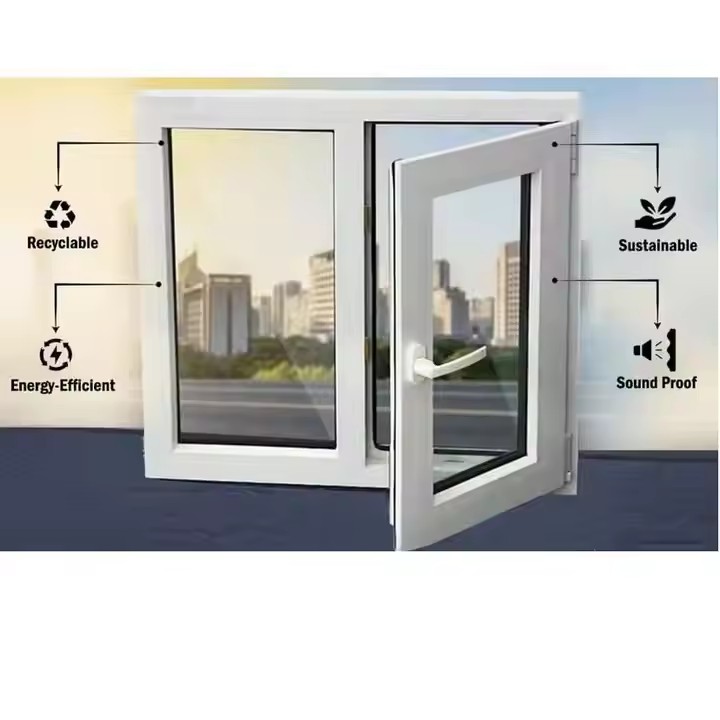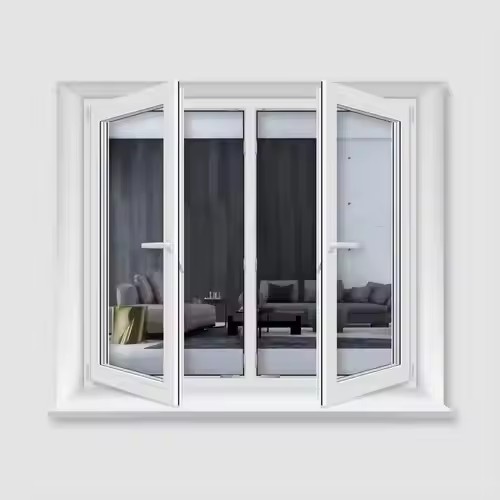Influence of Australian Architectural Environment on Folding Door Styles
Australia’s vast territory features diverse climates: temperate maritime climates with humid and rainy conditions in the south, hot and humid tropical climates in the north, and dry arid zones in the inland. Such climatic variations directly impact folding door design requirements:
Climate Adaptability: Coastal areas (e.g., Sydney, Melbourne) require wind-resistant and corrosion-proof styles, inland regions (e.g., Adelaide) prioritize thermal insulation and airtightness, while tropical areas (e.g., Cairns) emphasize ventilation and insect protection.
Architectural Style Orientation: Traditional Australian architectures like “Queenslander” wooden houses favor transparent and lightweight designs, while modern residences pursue minimalist lines and integration with large-area glass, requiring folding door styles to balance functionality and aesthetic adaptability.
Lifestyle Needs: Australian families value the integration of outdoor spaces (e.g., terraces, courtyards) with interiors. Folding doors, often serving as “space connectors,” need high opening capacity and easy operation.

Classification and Technical Characteristics of Mainstream Australian Folding Door Styles
Classification by Opening Direction and Structure
Side-Hung Folding Doors
Technical Features: Panels are suspended via top or bottom tracks, connected by hinges, folding unilaterally or bilaterally. The track system typically uses aluminum alloy or stainless steel, with strong load-bearing capacity (single panel load up to 80-120kg).
Australian Applications: Widely used in villa terraces and sunrooms. For example, coastal villas in Perth often adopt this style, paired with ultra-clear glass to enhance light transmission, while tracks hide drainage grooves to prevent rainwater backflow.
Detail Innovation: Some high-end models incorporate “hidden hinge” designs for a sleeker appearance, with anti-corrosion coatings (e.g., fluorocarbon paint) on hinges to adapt to coastal high-salt fog environments.
Floor-Guided Folding Doors
Structural Advantages: Bottom tracks bear weight, and top tracks guide, ensuring high stability for large-span spaces (e.g., open kitchens connected to courtyards over 6 meters wide). In the Australian market, track grooves commonly measure 15-20mm deep to prevent dust accumulation affecting sliding.
Anti-Slip and Safety Design: In rainy areas like Brisbane, floor tracks often feature anti-slip textures, and some models are equipped with anti-pinch sensors (especially for families with children).
Material Upgrade: Track profiles mostly use 6063-T5 aluminum alloy with a hardness of over 10 WEHR’s, and added silicon-magnesium alloys to enhance wear resistance.
Top-Hung Folding Doors
Spatial Advantage: Trackless design ensures a flat floor for easy cleaning, suitable for barrier-free indoor-outdoor passage (e.g., nursing homes, hospitals). In high-end Australian residences, this style often combines with underfloor heating systems to avoid track interference with heat dissipation.
Load-Bearing Technology: Top pulley sets use stainless steel bearings, with single-wheel load capacity up to 50kg, and pulley tracks embedded with shock-absorbing rubber strips to keep sliding noise below 40 decibels (compliant with Australian building acoustics standard AS 1045).
Classification by Profile and Glass Configuration
Thermally Broken Aluminum Folding Doors
Energy Efficiency Core: The Australian Building Code (NCC 2022) requires doors and windows to have a U-value ≤2.5W/(㎡·K). Thermally broken aluminum profiles block heat conduction via PA66 thermal breaks, paired with double-layer insulated glass (6mm+12A+6mm), achieving a U-value as low as 1.8W/(㎡·K), suitable for cold winter areas like Melbourne.
Surface Treatment: Profiles often use anodizing or powder coating. Coastal areas prefer fluorocarbon spraying (e.g., PVDF coating), passing 1000-hour salt spray testing (ASTM B117 standard).
Narrow Frame Folding Doors
Aesthetic Trend: Influenced by minimalism, narrow frame designs (frame width 20-30mm) are popular in modern Australian apartments (e.g., high-rises in Sydney CBD), with glass proportion increasing to over 85% to enhance visual permeability.
Strength Optimization: Despite reduced frame width, the profile section adopts a “multi-cavity structure,” enhancing wind resistance via reinforced ribs (withstanding category 10 typhoons in coastal areas), commonly selected for high-rises in the Gold Coast.
Double-Glazed Folding Doors
Composite Functionality: Besides thermal insulation, double-glazed laminated designs (e.g., PVB film) reduce noise by over 35 decibels (complying with Australian residential noise standard AS 2042), often used in homes near highways (e.g., Brisbane suburbs). Some models have built-in blinds for integrated sunshade and privacy protection.

Customized Styles for Application Scenarios
Landscape Folding Doors
Oversized Span Design: Australian family courtyards often connect to living rooms, supporting multi-panel folding (up to 12 panels), which can fully hide against side walls when opened, creating a “boundary-free” space. For example, winery villas in Adelaide often use 90-degree corner folding doors for 360° landscape views.
Sealing Technology: Panel edges are equipped with EPDM rubber seals, combined with multi-point locking hardware systems (single-point/multi-point locks), achieving a water tightness of 500Pa (compliant with AS 4420.1).
Commercial Folding Doors
High-Frequency Use Optimization: Restaurants and cafes use pulley sets with a service life of over 100,000 cycles (tested by Australian ATA), and profile surfaces undergo anti-scratch treatment (hardness ≥2H). The open-air restaurant at Melbourne’s Federation Square adopts this style, paired with intelligent sensing systems for automatic opening.
Technical Innovations and Future Trends of Australian Folding Doors
Intelligent Integration: Some high-end models embed IoT chips, supporting APP-controlled opening/closing, real-time airtightness monitoring, and even linkage with smart home systems (e.g., automatic closing during heavy rain), gradually popularizing in Sydney’s smart homes.
Sustainable Material Application: In response to Australia’s “2050 Carbon Neutrality” goal, some brands introduce recycled aluminum profiles (≥70% recycled aluminum), and glass edge sealants use silicone environmental glue (VOC content <100g/L).
Modular Design: To adapt to Australia’s DIY market, folding doors adopt modular components, allowing users to combine panel quantities and opening directions freely. Building material supermarkets like Bunnings have launched standardized installation kits.
Typical Cases: Analysis of Local Australian Brand Styles
Dulux Trade Series: Focuses on anti-corrosion and color customization. The “Coastal Pro” style, designed for Tasmania’s coastal areas, adds a zinc alloy protective layer to profiles, paired with blue-gray glass to echo marine landscapes.
Austral Windows’ Elite Fold Series: Adopts a “hidden drainage system” with independent water tanks below the track, draining 30% more efficiently than traditional styles, outstanding during Brisbane’s rainy season.
TrendWindows’ UltraSlim Series: Narrow frame design with Low-E glass achieves a U-value as low as 1.5W/(㎡·K), meeting Melbourne’s Green Star certification requirements.

